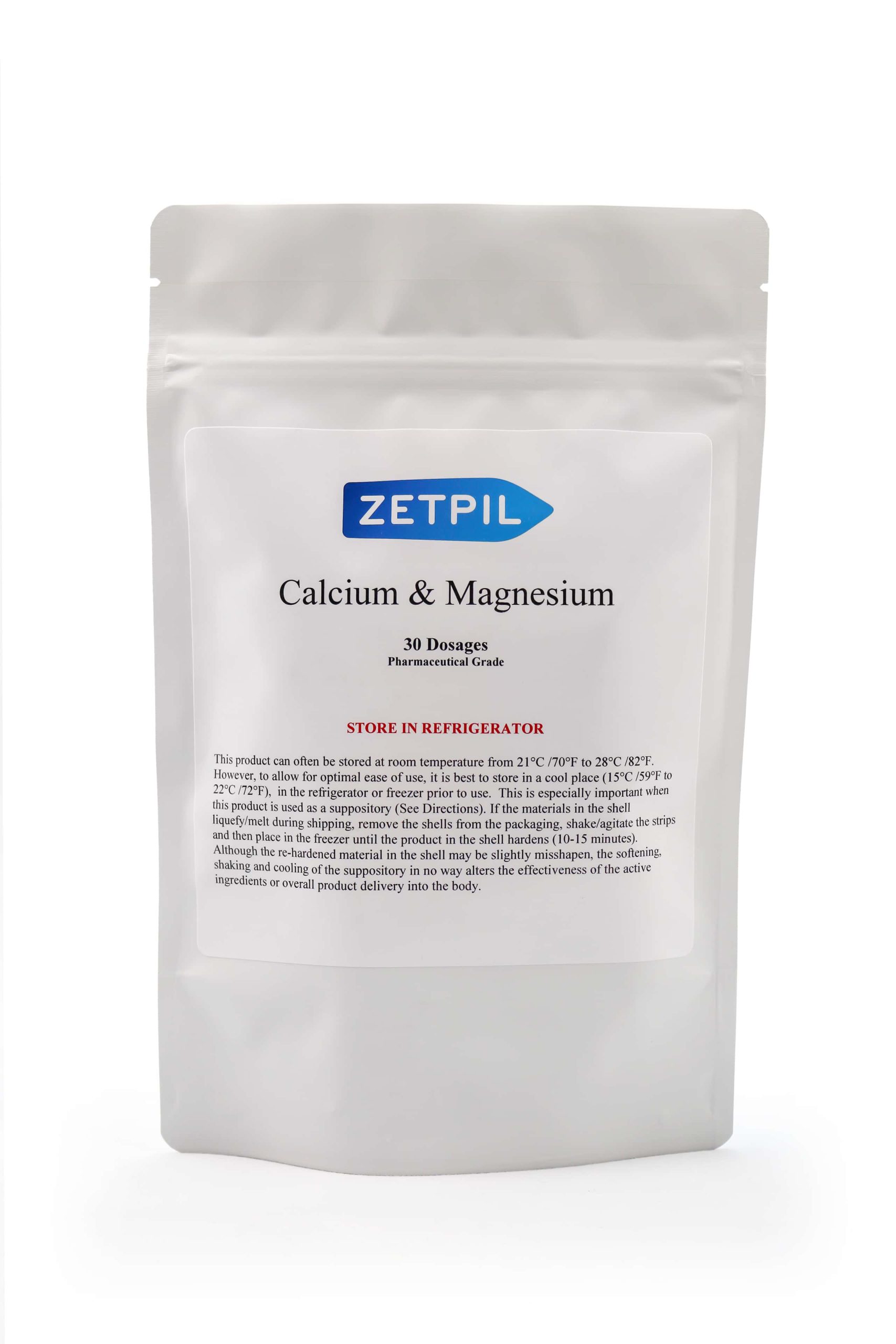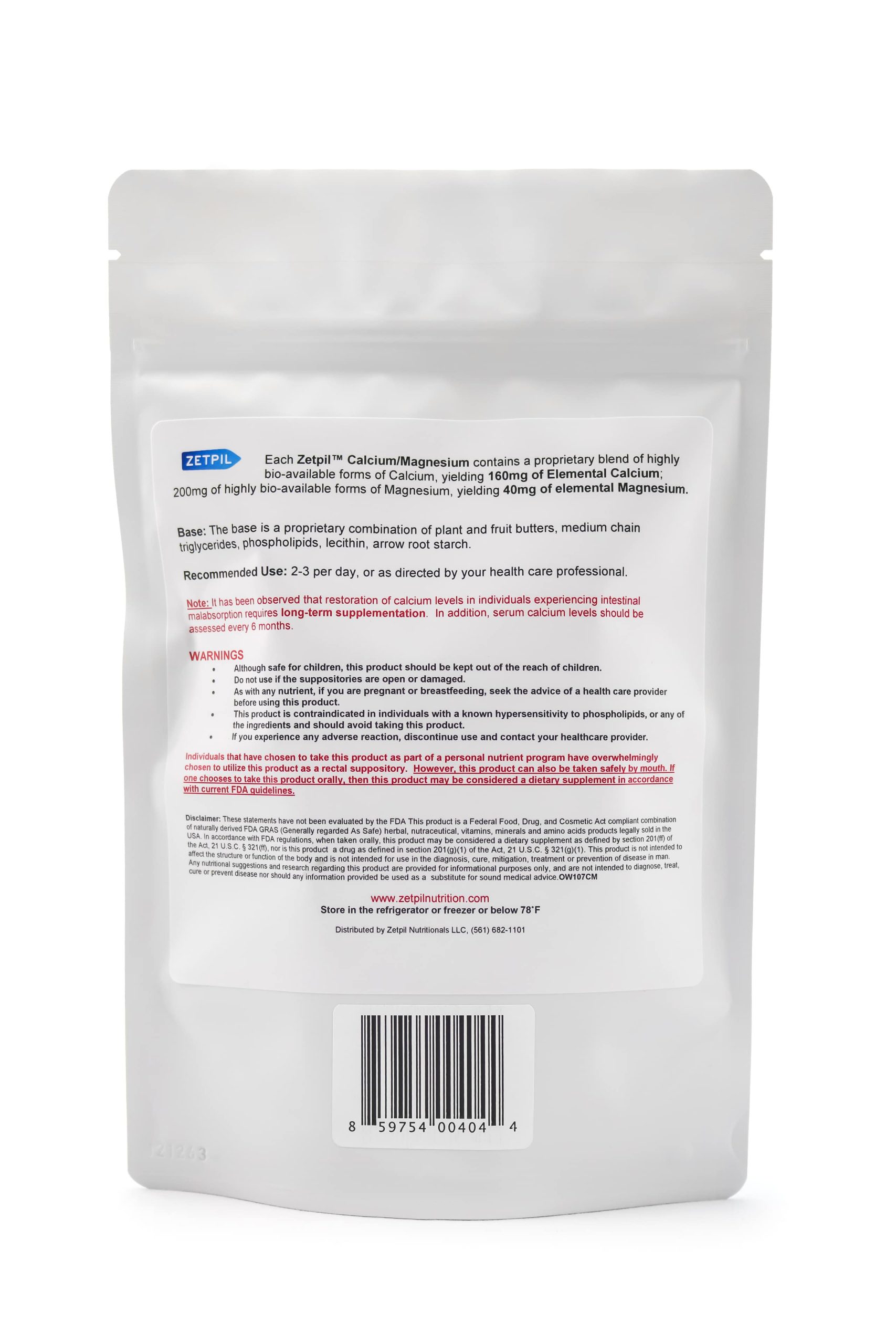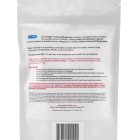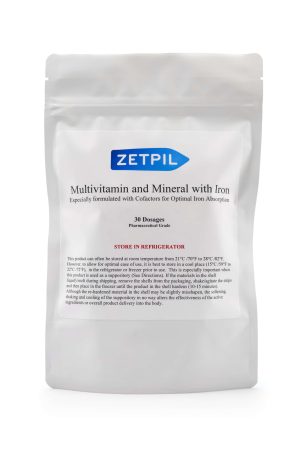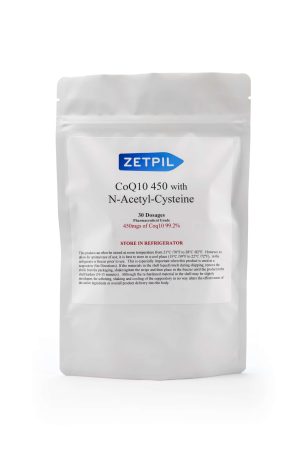Description
Overview of Important Information
It is VERY IMPORTANT to note that the key in understanding calcium supplementation is to understand that the most important factor is the amount of elemental calcium absorbed. Each suppository delivers 136mgs of elemental Calcium. This is the equivalent of six (6) 500 mg calcium citrate capsules or tablets. This is because calcium citrate is approximately 78-80% citric acid. In one capsule there is really 100mgs of calcium. Additionally, calcium is absorbed in the upper part of the small intestine (duodenum), and as little as 7-20% of the dietary elemental calcium ingested is absorbed. That means that when an adult takes a 500mg calcium citrate supplement only 20-25 mgs are actually absorbed by the body.
Zetpil™ Suppository Advantage
Zetpil™ delivers nutrition via the rectum with the use of suppositories that have a unique, all- natural formulated base that has revolutionized not only this mode of delivery, but also the ability to obtain nutrients in a far more efficacious method. These suppositories are a result of combining natural ingredients with a non-irritating, rapid melting (5-6 minutes), readily absorbable (superior retention), antioxidant base material (free radical scavenging ability) and delivers the nutrients directly into the bloodstream in less than 20 minutes in a highly effective manner. Oral supplements are exposed to the hazards of stomach acid, digestive enzymes, food-related breakdown, first pass metabolism, and other bioavailability issues in the gastro-intestinal system.
Additionally, many raw materials simply have a very low bioavailability , and only achieve around 10% or less (commonly <1%) absorption rates, even if the patient is in optimal health condition. Compromised health, age, or certain conditions that result in an inability to take oral nutrients often preclude these patient populations from obtaining the necessary nutrition to stay healthy which often exacerbates chronic health issues.
Zetpil™ suppositories are a NOW solution to delivering the necessary nutrients to patients, on a daily basis, that is both easy, comfortable and cost effective. The safety and noticeable effectiveness of these products will far outweigh any initial hesitation you have regarding this mode of delivery.
Most healthcare professionals are profoundly unaware of this fact. Therefore the recommendation of oral 1000mgs of calcium citrate by medical professionals is ONLY 40 mgs of absorbed elemental calcium – less than 1/10 of what is needed on a daily basis. THEREFORE, the suppository delivery of calcium offers a viable alternative for persons who need adequate amounts of calcium to meet their healthcare needs.
Benefits of Calcium and Magnesium
A Trio of Essential Nutrients
1. Calcium
Most people only see calcium as essential to strong bones and teeth, and while 99% of the body’s calcium is found at these two sites, calcium has multiple functions in our bodies. Calcium is essential for the regulation of blood clotting, sending and receiving nerve signals, contracting and relaxing muscles, releasing hormones and other chemicals, and keeping a normal heartbeat. Although osteoporosis and osteopenia are the primary diagnoses of calcium deficiency, other serious health issues can occur with calcium deficiency. These include, but are not limited to:
- arthritis and joint pain,
- muscle cramps, spasms, and twitches,
- nervousness,
- neuromuscular excitability,
- eczema,
- high blood pressure,
- back pains (sciatica, disc problems),
- panic attacks and depression,
- insomnia, and
- periodontal disease.
2. Magnesium
“Magnesium has been recognized as a cofactor for >300 metabolic reactions in the body, (and therefore) plays a major role in disease prevention and overall health. There is no major food that provides an extremely high amount of magnesium” and therefore supplementation is crucial to maintaining healthy, normal magnesium levels. http://www.ncbi.nlm.nih.gov/pmc/articles/PMC3650510/ Due to its multitude of actions within the body, magnesium deficiency is often an overlooked clinical diagnosis which is troublesome because correcting this deficiency is relatively easy with broad positive effects.
Low levels of magnesium have been associated with a number of chronic diseases including, but not limited to:
- migraine headaches,
- Alzheimer’s disease,
- cerebrovascular accident (stroke),
- type 2 diabetes mellitus,
- hypertension and cardiovascular disease. http://www.ncbi.nlm.nih.gov/pmc/articles/PMC3592895/
“Loop and thiazide diuretics (often prescribed for hypertension and/or congestive heart failure), can further exacerbate magnesium loss, typically through the urine.” http://www.ncbi.nlm.nih.gov/pmc/articles/PMC3650510/
3. Vitamin D
There is now overwhelming scientific research that low Vitamin D3 levels and the associated calcium deficiency are linked with some cancers (e.g. renal, prostate, endometrial, ovarian, esophageal, gastric, pancreatic, bladder), Hodgkin’s and non-Hodgkin’s lymphoma as well as cardiovascular disease, neuromuscular dysfunctions, Diabetes mellitus Type I, gingivitis, tooth decay and tuberculosis. Recent research suggests that current FDA recommendations are grossly inadequate to maintain healthy, disease-preventing levels of vitamin D.
Previously, the recommended level of vitamin D was between 40 to 60 ng/ml, but more recently the optimal vitamin D level has been raised to 50-70 ng/ml, and when treating cancer or heart disease, as high as 70-100 ng/ml. Therefore, the current guidelines recommending 600-800ius/day of vitamin D supplementation without appropriate serum testing to maintain adequate levels is a horrible disservice.
Individuals MUST obtain their vitamin D serum levels from blood testing, supplement accordingly, and then re-test to ensure proper absorption and level increases. There are no arbitrary dosages and this process is the only one that will ensure appropriate vitamin D levels.
The Scientific Evidence
Why what you have been told may not be scientifically valid…..
First, to repeat from the information above, the most important piece of information is to understand how much elemental calcium is absorbed from supplements. Calcium citrate products, most often recommended by medical practitioners, will not afford you the levels of elemental calcium necessary to maintain optimal levels and prevent calcium deficiency-related health issues.
Second, there are a number of food combinations and other dietary factors that block calcium absorption from the intestines, including, but not limited to:
- High intake of oxalates and phytates (found in foods such as spinach and whole grains)
- Consumption of alcohol, coffee, caffeinated beverages, energy drinks, and sugar
- Medications:
- Anti-seizure medications,
- Benzodiazepines (e.g. Xanax, Valium, Ativan),
- Thyroid medications,
- Diuretics, and
- Aluminum-containing antacids (e.g. Tums).
Third, low estrogen levels in women and low testosterone levels in men will also further reduce elemental calcium absorption to levels as low as 8-10%.
Fourth, inadequate levels of Vitamin D3 (below 40ng/mL) will also negatively affect adequate calcium absorption.
Finally, this product is especially important for patients who suffer from subclinical nutrient malabsorption, conditions in which nutrient malabsorption is a fundamental part of the disease (i.e. celiac disease, Crohn’s Disease, Cystic Fibrosis) or have undergone surgical malabsorption procedures including but not limited to Roux en Y Gastric Bypass Surgery, Biliopancreatic Diversion, Duodenal Switch, Gastric Sleeve (VSG), Vertical Banded Gastroplasty (VBG) WLS-Bypass and Gastric Band and Mini Gastric Bypass Surgery.
Oral calcium forms (even the better forms such as calcium citrate) will not meet the needs of most patients and certainly not meet of the needs of the patients with obvious deficiencies.
Safe Alternatives
The Zetpil™ Calcium and Magnesium Suppository is a SAFE ALTERNATIVE to Bisphosphonates (Fosamax, Actonel, Zometa and Boniva)
As described above, many healthcare professionals believe that the best way to treat and/or prevent osteoporosis or osteopenia is by the dietary intake of foods containing calcium and/or the use of oral calcium supplements. However, the inability of many individuals to ingest and absorb adequate calcium levels prompted the pharmaceutical industry to develop a new class of medications called bisphosphonates (http://en.wikipedia.org/wiki/Bisphosphonate). Aggressive marketing has influenced many in the medical community to tout these pharmaceutical drugs (Fosamax, Actonel, Zometa and Boniva) as the best preventative approach or even the best treatment approach for osteoporosis and/or osteopenia.
However, there are many medical professionals who are warning that the side effects and risks of these medications do not outweigh their purported benefits.
- First, bisphosphonates work by inhibiting bone resorption. Unfortunately that’s not as good as it may sound. Bone formation requires a certain amount of bone resorption. Therefore, if resorption (e.g. bone loss) is delayed, then so is new bone formation. In fact, the development of osteonecrosis (bone decay) with the use of Fosamax may be based on this effect.
- Second, these medications still require adequate intake of calcium and vitamin D.
“Ensuring adequate calcium and vitamin D intake both before and after initiation of bisphosphonate therapy is an extremely important but frequently overlooked aspect of providing optimal care of skeletal health. Vitamin D insufficiency is widely acknowledged to be prevalent in nearly all patient populations prescribed bisphosphonate therapy, particularly in the elderly.” http://www.ncbi.nlm.nih.gov/pmc/articles/PMC2704135/
- Third, it is well known in the medical community that medications have side effects. While some side effects of bisphosphonates are minor/common such as bone, muscle and joint pain, constipation, or flu-like symptoms, others can be severe such as rash, difficulty breathing, chest pain, severe heartburn, or swelling in the hands, legs, feet or jaw. In fact, the use of Fosamax and Fosamax D have been linked to the painful and often disfiguring and irreversible condition osteonecrosis (bone decay) of the jaw (also referred to as ONJ, Dead Jaw of Bis-Phossy Jaw), hip, shoulder or knees. Remarkably, Fosamax is still the most prescribed medication for osteoporosis/osteopenia.
Drs. Kurt Kennel and Matthew Drake out of the Mayo Clinic co-authored an excellent article (published in 2009 in the Mayo Clinic Proceedings) on the side effects of bisphosphonates and will serve as an indispensable reference for those looking to understand the risks of these medications. Please visit this website for a full-text copy of this article. http://www.ncbi.nlm.nih.gov/pmc/articles/PMC2704135/
References
References
Adverse Effects of Bisphosphonates: Implications for Osteoporosis Management
Mayo Clin Proc. Jul 2009; 84(7): 632–638
Kurt A. Kennel, MD and Matthew T. Drake, MD, PhD
http://www.ncbi.nlm.nih.gov/pmc/articles/PMC2704135/
Disorders involving calcium, phosphorus, and magnesium
Prim Care 2008 Jun; 35(2):215-37, v-vi
Moe SM
http://www.ncbi.nlm.nih.gov/pmc/articles/PMC2486454/
Does a higher ratio of serum calcium to magnesium increase the risk for postmenopausal breast cancer?
Med Hypotheses Sep 2010; 75(3): 315–318
Abe E. Sahmouna,* and Brij B. Singh
http://www.ncbi.nlm.nih.gov/pmc/articles/PMC3045769/
Hypocalcemia
Can Fam Physician Feb 2012; 58(2): 158–162
Jeremy Fong
http://www.ncbi.nlm.nih.gov/pmc/articles/PMC3279267/
Serum fat-soluble vitamin deficiency and abnormal calcium metabolism after malabsorptive bariatric surgery
J Gastrointest Surg 2004 Jan;8(1):48-55; discussion 54-5
Slater GH
http://www.ncbi.nlm.nih.gov/pubmed/14746835
Role of calcium malabsorption in the development of secondary hyperparathyroidism after biliopancreatic diversion
J Endocrinol Invest 2008 Oct; 31(10):845-50
Balsa JA
http://www.ncbi.nlm.nih.gov/pubmed/19092286
Evolution of the Calcium Paradigm: The Relation between Vitamin D, Serum Calcium and Calcium Absorption
Nutrients Sep 2010; 2(9): 997–1004
Borje E. Christopher Nordin
http://www.ncbi.nlm.nih.gov/pmc/articles/PMC3257716/
Magnesium in Disease Prevention and Overall Health
Adv Nutr May 2013; 4(3): 378S–383S
Stella Lucia Volpe
http://www.ncbi.nlm.nih.gov/pmc/articles/PMC3650510/
Vitamin D and Calcium Insufficiency-Related Chronic Diseases: an Emerging World-Wide Public Health Problem
Meinrad Peterlik, et al.
Int J Environ Res Public Health 2009 October; 6(10): 2585–2607
http://www.ncbi.nlm.nih.gov/pmc/articles/PMC2790094/
For those looking for further references regarding specific calcium and magnesium health issues,
we encourage you to visit www.ncbi.com for scientific, peer-reviewed, medical research.

